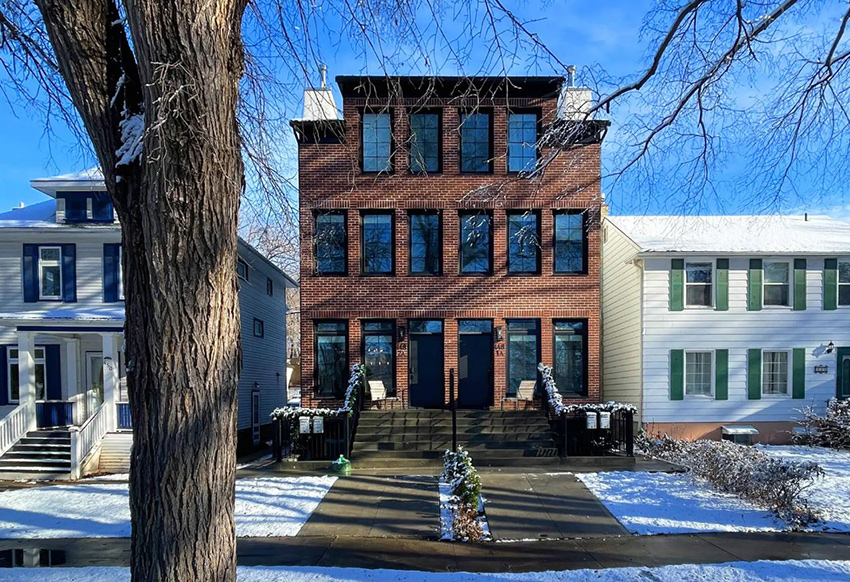By Brent Bellamy, Architect + Creative Director
Originally published in the Winnipeg Free Press
The federal government is trying to tackle Canada’s housing crisis by working directly with cities through a $4-billion program called the Housing Accelerator Fund (HAF). The initiative is designed to help cities rapidly increase the number of homes being built to level market demand and in turn stabilize housing costs and increase affordability.
Image: An example of a new fourplex infill development in Winnipeg’s St. Boniface neighbourhood. Photo - Brent Bellamy.
The government train has been heading across the country on a whistlestop tour to bring cities into the program, with a dozen already signed on and many more in the queue. This week’s stop is in Winnipeg, and on Thursday, council will consider a vote to become the next city aboard.
The reward is lucrative. Winnipeg’s share could be up to $192 million, but signing up requires a promise from each city to end what the government is calling ‘exclusionary zoning’ policy.
Exclusionary zoning is more technically defined as R-1 zoning. It covers most residential neighbourhoods in Canadian cities and allows no more than a single-family home to be built on each lot. It has become known as exclusionary because of its origins, and the social impacts it has to this day.
The first exclusionary zoning policy was implemented in the United States early in the 20th century to create racially segregated neighbourhoods.
When race-based planning was abolished by the U.S. Supreme Court, residents lobbied government to find a workaround to protect their “neighbourhood character” — a phrase still commonly used to oppose more diverse housing development.
The solution they found was to make it illegal to build anything but a single-family home in certain areas. This new policy created economically segregated neighbourhoods, often disproportionately tied to race, by ensuring that only people who could afford the most expensive housing type would have access to single-family zoned communities.
With the cost of an average single-family home in Winnipeg surpassing $400,000, the economic segregation that R-1 zoning creates still exists today and it’s growing.
Neighbourhoods that only welcome those who can afford a house, restrict access for lower income residents to socioeconomically integrated schools, more diverse social networks, employment and recreation, and the opportunity to begin building generational prosperity.
It also restricts access to good neighbourhoods for young families and seniors wanting to stay in their community as they downsize.
For Winnipeg to be accepted into the HAF program, the federal government is requiring that R-1 zoning be replaced with the allowance of up to a fourplex on every lot, citywide. They are also requiring four-storey residential buildings be allowed up to 800 metres from primary transit routes.
These moves are intended to increase viable locations for new housing, while establishing more diverse and socially equitable neighbourhoods. Winnipeg’s HAF application promises to build 14,000 new homes over three years. The amount of new infrastructure and public services required to accommodate that growth in new suburban sprawl would be financially crippling for the city, meaning new zoning rules are required to spread growth more evenly across existing neighbourhoods, connected to existing infrastructure.
The speed at which the federal government is forcing cities to act is causing strained debate in city halls across the country, but housing need is immediate.
The intent is that as-of-right zoning will be implemented to allow certainty for developers and reduce lengthy approvals and consultation processes that slow housing construction. The vote happening this Thursday is to accept this idea in principle, but it does not mean a wild-west development scenario will follow.
Once in the program, the city will be able to do public consultation and work with the federal government to create specific bylaws. The goal will be to establish a series of boxes that developers must check to receive as-of-right approval. These will likely include things such as height, setback, and lot coverage restrictions, as well as tree protection, runoff control, and sewer and water capacity requirements.
The Housing Accelerator Fund is designed to push cities to build more housing over an immediate three-year period, receiving money for every new home created above an established baseline. The fund also hopes to establish new ground rules for development that facilitate higher levels of housing construction long after the program is complete.
Along with the exclusionary zoning changes, Winnipeg will use the money to upgrade infrastructure, expedite permit applications, redevelop city-owned properties, and incentivize affordable housing, and housing built downtown and along commercial corridors.
The economic challenges of building infill housing will ensure that change in existing single-family neighbourhoods comes gradually even without exclusionary zoning.
After Minneapolis eliminated R-1 in 2020, the number of ‘plexes’ being approved each year has doubled, but still only represents about two per cent of all new housing built. This zoning reform is part of several policy changes Minneapolis has implemented to increase housing supply over the past decade, successfully doubling the number of new homes built annually.
Their results demonstrate that if Canadian cities can use the HAF to increase housing supply, affordability will follow. Minneapolis has seen nominal rents decrease since 2017, when in most cities they have grown significantly, and homelessness has declined despite increases in other Minnesota cities.
Joining the Housing Accelerator Fund will take a leap of faith by Winnipeg city council, and the pace of change may take us out of our comfort zone.
By accepting that a fourplex is not an evil developer creation, and is instead homes for families to live in, we might embrace this rare opportunity to redefine how we build our city, creating housing affordability, reducing homelessness, and establishing vibrant and equitable neighbourhoods for the next generations to call home.
Brent Bellamy is creative director at Number TEN Architectural Group.
